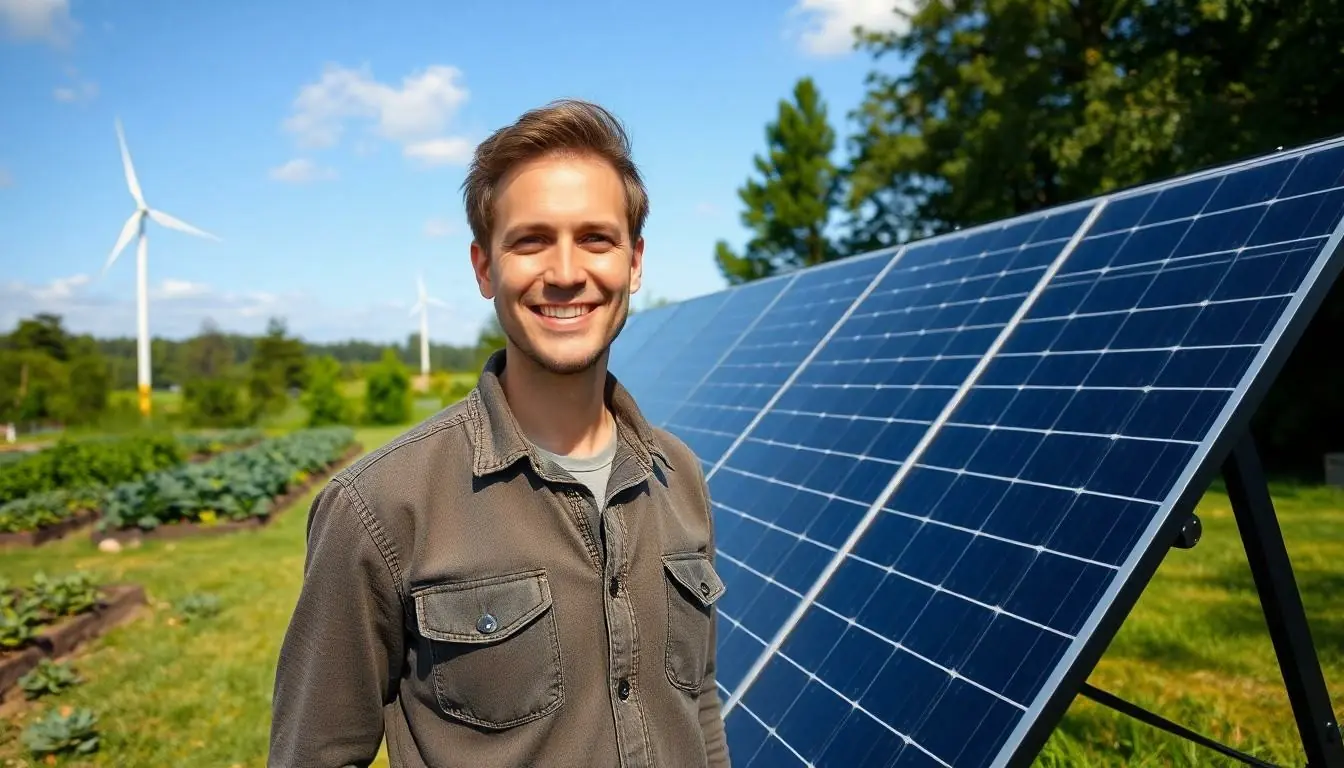In a world where plastic straws are the new villains and climate change feels like a recurring nightmare, sustainable living isn’t just a trend—it’s a necessity. Imagine sipping your morning coffee while saving the planet. Sounds dreamy, right? It’s time to turn that dream into reality.
Table of Contents
ToggleUnderstanding Sustainable Living
Sustainable living involves adopting habits that minimize one’s environmental impact. This lifestyle prioritizes practices that contribute to the health of the planet. Individuals can achieve sustainability by making informed choices about consumption and resource use.
Reducing waste significantly influences sustainable living. For example, choosing reusable products like water bottles and shopping bags decreases landfill contributions. Composting food scraps provides a natural way to enrich soil, promoting healthy ecosystems.
Energy conservation plays a crucial role in sustainability. Switching to LED lighting lowers electricity usage while saving money on utility bills. Using energy-efficient appliances lessens greenhouse gas emissions and conserves resources.
Water management also contributes to sustainable practices. Collecting rainwater for gardening or using low-flow fixtures reduces overall water consumption. Understanding local water sources helps individuals recognize their role in conserving this precious resource.
Transportation choices can enhance sustainable living as well. Walking, biking, or using public transport reduces reliance on fossil fuels. Carpooling options also expand, minimizing carbon footprints when commuting.
Food choices greatly impact environmental sustainability. Consuming locally sourced, organic produce lowers transportation emissions and supports local economies. Reducing meat consumption fosters land conservation and lessens water use required for livestock.
Awareness is vital in fostering a sustainable mindset. Educating oneself on environmental issues encourages responsible behaviors. Engaging in community initiatives can amplify positive changes, inspiring others to make sustainable choices.
Every action, whether large or small, contributes to the overarching goal of sustainability. Integrating these practices into daily life shapes a healthier planet for future generations.
Importance of Sustainable Living

Sustainable living plays a crucial role in addressing environmental challenges. Adopting eco-friendly practices creates a positive impact on the planet.
Environmental Benefits
Choosing sustainable methods actively reduces pollution and conserves natural resources. The adoption of reusable products cuts down waste in landfills and minimizes plastic production. Composting food scraps enriches the soil, supporting biodiversity and preventing methane emissions from waste. Efficient energy use, such as LED lighting and energy-efficient appliances, lowers carbon footprints significantly. Water management techniques, like collecting rainwater and utilizing low-flow fixtures, contribute to conservation. Transportation habits play an essential role too; opting for biking or public transit reduces fossil fuel reliance. Sustainable food choices, including local and organic options, promote healthier ecosystems. Each eco-friendly decision contributes to a more balanced environment.
Social Benefits
Sustainable living enhances community well-being and fosters social responsibility. Efforts to promote awareness and education inspire individuals to engage with sustainable practices. Communities that prioritize sustainability encourage connections through shared initiatives, such as recycling programs and community gardens. Supporting local businesses strengthens economies while reducing transportation emissions. Collaborative efforts create a sense of belonging, building a culture of responsibility. By choosing organic and locally sourced produce, individuals contribute to healthier food systems. The integration of sustainable living practices encourages hands-on learning opportunities, empowering individuals to advocate for change. Positive impacts develop from each choice made, leading to a more equitable society.
Key Principles of Sustainable Living
Sustainable living centers on actionable principles that reduce environmental impact. Implementing these principles leads to a healthier planet and more equitable society.
Reduce, Reuse, Recycle
Reduce, reuse, and recycle form the cornerstone of sustainable waste management. By limiting consumption, individuals minimize waste generation. Choosing reusable products significantly cuts down on single-use plastics. Recycling programs provide an avenue for repurposing materials, conserving resources. Communities that engage in these practices often experience lower landfill contributions, resulting in cleaner environments. Awareness around recycling guidelines enhances effectiveness and fosters collective responsibility. Implementing these habits not only addresses waste issues but also promotes circular economies that benefit local ecosystems.
Energy Efficiency
Energy efficiency plays a critical role in sustainable living. Investing in energy-efficient appliances decreases electricity consumption, which leads to lower utility bills. Utilizing LED lighting significantly reduces energy use compared to traditional bulbs. Homeowners can optimize their energy efficiency by employing smart home technologies that automatically adjust usage patterns. Insulating homes effectively minimizes heating and cooling demands, which conserves energy resources. Communities that embrace energy efficiency not only preserve natural resources but also inspire others through shared initiatives and programs. Prioritizing these practices makes a tangible difference in combating climate change.
Practical Tips for Sustainable Living
Living sustainably involves making conscious choices in daily life that positively impact the environment. Below are practical strategies to foster sustainability in transportation and home practices.
Sustainable Transportation Options
Walking and biking serve as effective alternatives to driving, significantly cutting carbon emissions. Public transport systems, such as buses and trains, provide eco-friendly travel options when available. Carpooling reduces the number of vehicles on the road, also lowering traffic congestion. Utilizing electric or hybrid vehicles further minimizes fossil fuel reliance, contributing to cleaner air. Choices in transportation directly affect environmental sustainability and offer healthier lifestyle options.
Eco-Friendly Home Practices
Incorporating energy-efficient appliances lowers household energy consumption while saving money. Using LED bulbs enhances lighting efficiency and reduces electricity bills. Water conservation methods, including low-flow fixtures and rain barrels, effectively reduce water usage. Composting kitchen scraps keeps organic waste out of landfills and enriches soil. Opting for non-toxic cleaning products promotes indoor air quality and supports a healthier environment. Each of these practices actively contributes to a sustainable lifestyle while creating a positive impact on the planet.
Challenges to Sustainable Living
Sustainable living faces several significant challenges that impact individuals and communities. One major obstacle is the lack of accessible resources, particularly in low-income areas. Limited options for purchasing eco-friendly products restrict people’s ability to make sustainable choices.
Costs associated with sustainable living can deter engagement in eco-friendly practices. People often perceive organic food or energy-efficient appliances as expensive, discouraging them from adopting these beneficial habits. Affordability remains a barrier that requires addressing to enhance participation in sustainable initiatives.
Awareness and education also present challenges in transitioning to sustainable lifestyles. Many communities lack proper educational programs that promote understanding of sustainable practices. Without this knowledge, individuals may struggle to make informed decisions about their impact on the environment.
Cultural norms can complicate sustainable living as well. Practices deeply ingrained in society, like excessive consumerism, conflict with sustainability goals. Changing these habits demands dedicated efforts and community engagement to reshape perceptions and behaviors toward eco-friendliness.
Infrastructure limitations further hinder sustainable transportation options. In many regions, public transport systems are underdeveloped, making it difficult for individuals to rely less on personal vehicles. Improved public transport and cycling infrastructure can encourage environmentally friendly commuting habits.
Resistance to change often arises when discussing sustainability. Individuals and businesses may find comfort in established routines, making them reluctant to shift toward sustainable practices. Overcoming this inertia requires motivation and clear examples of the positive impact of sustainable living.
Collectively, these challenges necessitate concerted efforts from individuals, organizations, and governments. Working together, communities can promote understanding, accessibility, and infrastructure progress, ultimately making sustainable living more attainable for everyone.
Embracing sustainable living is a journey that requires commitment and collective action. By making informed choices and adopting eco-friendly practices, individuals can significantly reduce their environmental footprint. Every small step taken towards sustainability contributes to a larger movement that benefits not just the planet but also local communities and economies.
As awareness grows and resources become more accessible, the shift towards sustainable lifestyles becomes increasingly attainable. It’s essential for everyone to engage in this vital mission, fostering a sense of responsibility that inspires others. Ultimately, the future of the planet hinges on the actions taken today, and each person’s contribution is invaluable in creating a healthier and more equitable world for generations to come.







